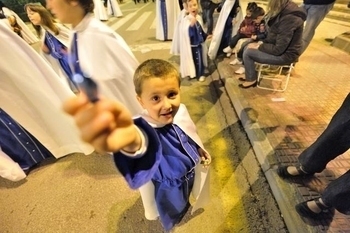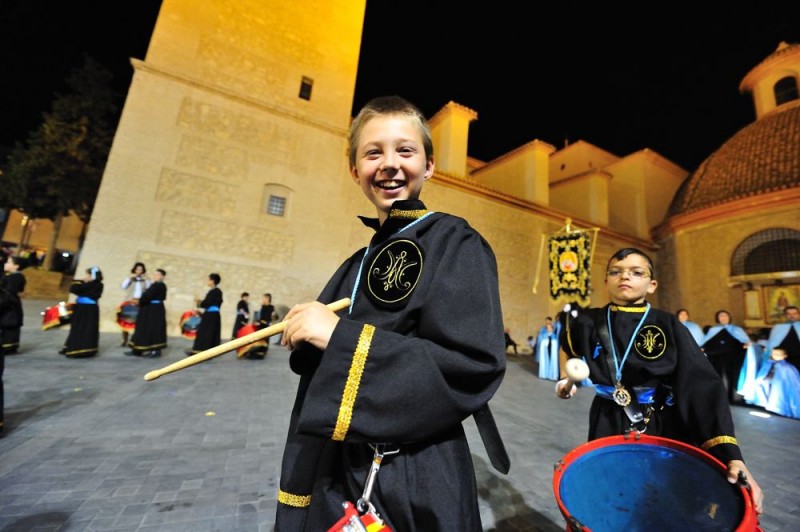Martes Santo, Holy Tuesday in Alhama de Murcia

One of the highlights of Semana Santa in Alhama de Murcia
The Semana Santa processions in Alhama de Murcia may not be as well known or as majestic as those in Lorca, Cartagena and the city of Murcia, but the town is large enough for their to be numerous "pasos" or religious figures paraded in the streets, and at the same time small enough to offer a heartfelt welcome and an enveloping experience where community and participation are more important than putting on a show.

The Tuesday procession sets out from the church of San Lázaro, where the Plaza provides an atmospheric backdrop with softly mellowed brickwork and warm smooth stone creating a timeless feel to the procession. The parade includes all of the Cofradías (or Brotherhoods), of which there are five in Alhama, the Morados (purple), Azules (blue), Colorados (red), Blancos (white) and Negros (black),owning more than 50 pasos or sculptural pieces etween them.
Each has what is known as a Titular, a leading statue which is the main figure around which the brotherhood revolves, and in Alhama these figureheads are Nuestro Padre Jesús Nazareno, Verónica, María Magdalena, San Juan Evangelista and the Virgen de los Dolores, affiliations which are often repeated across the Region of Murcia.

Semana Santa in Alhama has been declared of Regional Tourism Interest, and the processions are a tradition which dates back to the 17th century. The Paso Negro, the Hermandad de Nuestra Señora de los Dolores y de la Soledad, appears in an early form within a book held within the municipal archive which is dated 1635, although the cult which evolved into the paso as it is today doesn't appear in the archives until 1737, a date by which the Paso Morado, The Archicofradía de Nuestro Padre Jesús Nazareno is also known to have existed.

In the early 1920's the other 3 Cofradías are known to have been participating in Semana Santa acts, but the blight of the Civil War (1936-39) devastated Alhama, leaving a decimated heritage and destruction in its wake, and the traditions of Semana Santa were interrupted until the mid 1940's. The precious sculptural heritage of Alhama de Murcia was nearly all destroyed, burnt during the anti-clerical wave of the conflict, amd just a precious few pieces survived, for the most part hidden by citizens who couldn't bear to see the pieces they held in such high esteem destroyed.
There are pieces right across the Region which bear the signs of varnish darkened by smoke as they were snatched from burning churches by parishioners and hidden in barns and farmyards during the Civil War, and others which have new robes or just the head and hands survived, the remainder replaced after the war.

One such figure in Alhama is that of the Mujer Verónica, owned by the Paso Colorado, her salvation the source of many popular legends. Some say she was in the home of private individuals when the remainder were burnt, and was concealed in a hidden chamber until danger had passed. Others say that to conceal her better the body was cut in half and hidden in two pieces, but that only the top part survived: still others say that she is all original and was never cut in two. Regardless of the legends, the Veronica who participates in these Semana Santa processions is a lucky survivor and goes forth as a whole piece, one of only two original pasos.
Following the horrors of the war the traditions were gradually reinstated, starting in 1946. Since then the Cofradías have been slowly replacing their lost heritage with new pieces, a painstakingly slow process due to the cost of acquiring new sculptures.

But the real joy of Semana Santa in Alhama lies not in the works of religious art, but in the participation of all ages, babes in arms sporting the tunics of the Cofradía they were born into. Barely able to walk, fledgling Nazarenos toddle along the streets dispensing sweets to onlookers, little stomachs bulging under the weight of sweets stuffed inside their tunics, merrily munching the booty as the paso sways along the street behind them, the air ringing with cries of "Viva la Virgen!" and the melodic shuffle of leather on marble, accompanied by the rhythmic beat of drums.

It's a passage made more intimate by the narrow streets of the old town centre, even though on this Tuesday night procession some of the pasos are carried on mechanical platforms rather than by human bearers, the ever practical people of Alhama having very cleverly purchased mechanical bearers which sway to imitate the real thing as they make their way along the circular route back to the church.

Click here for details of the whole of Semana Santa in Alhama, including the famous Easter morning parade!
For more local information, including news and forthcoming events, visit the home page of Alhama Today.











